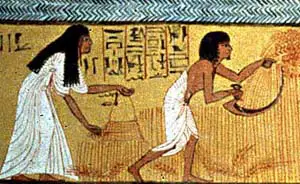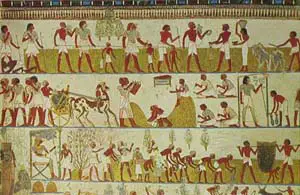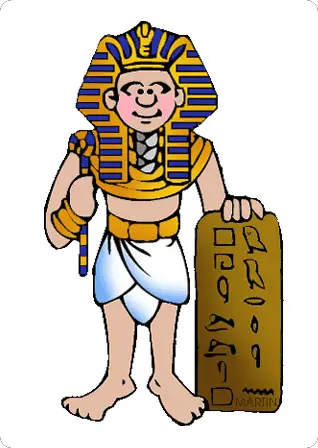Egyptian Farming
The ancient Egyptians had the ability to grow everything they needed to eat. Although Egypt is a desert, the Egyptians settled near the Nile River. Every year the Nile floods for three months, bringing rich soil and silt that fertilizes the land. Egyptians developed a well-designed system of canals to bring the water from the Nile into other areas and using farming techniques, they grew a wide variety of foods.


Most farming that we are familiar with requires the use of ploughs to turn the soil to bring up nutrient rich soil upwards. The Egyptians had little ploughing to do because the flooding of the Nile deposited all of the rich soil directly on top. They only needed to lightly turn the soil, so ploughs were lighter weight and usually attached to the horns of cattle. If cows were not available, the plough was so light that humans could pull it. Another way to turn the soil was for the people to use hoes.

Once the soil was turned, people would follow behind with a basket filled with seeds hanging around their neck and ‘sow’ the seeds into the fresh earth. The amount of fertilized land left by the Nile flooding each year was between 20,000 and 34,000 square kilometers. This gave the Egyptians a lot of good soil to raise their crops on.
Just prior to harvesting, tax collectors would go around and survey the amount of crops and land so that they could estimate taxes due. Harvest time for the crops happened between April and June. Everyone took part in the harvesting and the very wealthy families would actually hire teams of people to do the harvesting. Harvesting the tall grain plants such as wheat, barley and flax was done using a sickle and then the grain was put into large bundles to be carried away.


There were many types of crops that were raised by the Egyptians: corn, wheat, barley, flax, onions, leaks, cabbages, cucumbers, beans, lettuce, figs, melons, pomegranates, vine plants. Many types of trees that were fruit bearing. Wheat and barley were the most popular crop because they used wheat to make the bread that everyone ate and barley was used to make beer. Beer was popular due to the fact that safe fresh water was not easily available and the brewing process of beer made it safe to drink. The flax plant grew naturally, but since the Egyptians used it to make the linen for their clothes, they also included it as part of their crops.

Corn was another popular crop. Once it was harvested, anything that was left over was stored in glazed storage containers and used to feed the farming animals. The containers had to be sealed to keep insects and rodents out as well as keeping it dry so that it would become moldy.
Many of the crops were grown in the fields but there were also a number of gardens that had fruit trees, flowers and vegetables. The pharaoh had a private garden that was large and well decorated with flowers, trees and a pond. Many of the wealthy people also had gardens with ponds and there were public gardens set aside for use by the community. Olive trees were one of the prized trees because they not only ate the olives, but used olive oil for cooking and lighting their lamps.

Every year, the ancient Egyptians could count on the flooding of the Nile to bring the rich soil so that they could plant and harvest the crops. There were, however, some years that the Nile didn’t flood or flooded very little. This would cause a drought and if they didn’t have food set aside, many people could starve. The people thought of the pharaoh as their ‘god’ and as such, it was the job of the pharaoh, to ensure that he had scribes that kept track of the amount of grain harvested as well as setting some aside in case of drought.



